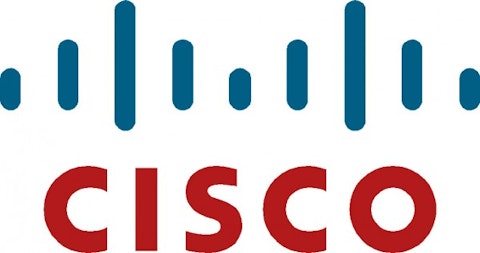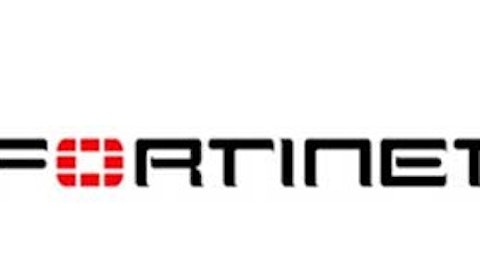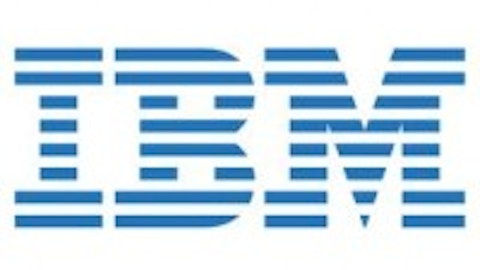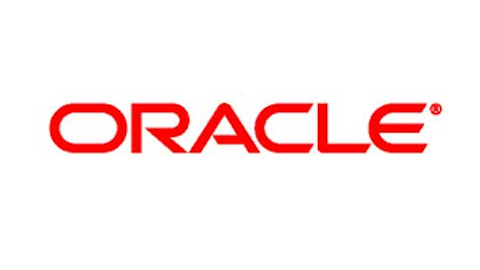The world’s largest supplier of computer networking systems, Cisco Systems, Inc. (NASDAQ:CSCO), has done pretty well for its shareholders lately, up nearly 40% since last July on the strength of a few good quarters combined with solid performance for tech stocks in general. With the company set to report fiscal year 2013’s second quarter earnings on Feb. 13, investors have high hopes. When a company has an upside move like Cisco has had over the past six months or so, investors are faced with a tough decision: sell and take profits, or hold and hope for even more.
The Company
Cisco offers a variety of routers and switching products to connect local and wide area computer networks. The company primarily sells its products through its reseller partners, of which there are over 40,000 around the world. Cisco derives 55% of its sales from North and South America, with 17% coming from Asia, and the rest from Europe, the Middle East, and Africa.

As mentioned earlier, Cisco has a dominant market share in both routers (51.4%) and switches (60.3%). It has ventured into the server market in recent years with its unified computing solution (UCS), which aimed to make data centers more efficient.
Shareholder Value
There are two major ways that long-term investors look to companies to create value: dividends and buybacks. Cisco delivers in both categories. The company is relatively new at the dividend game, paying its first quarterly dividend in April 2011. The payout has been increased 75% since, and I would be very surprised if Cisco did not raise the dividend again, most likely in the second half of the year (they last increased it in August 2012).
As mentioned, Cisco does have an ambitious buyback program. After slowing down buybacks during the recession, the company has done an admirable job of reducing the number of outstanding shares lately, and since 2010 the number has gone from 5.848 billion to 5.29 billion shares, for a reduction of 9.5% in less than three years.
Valuation
The major reason I like Cisco as a long-term investment is its incredibly cheap valuation. Cisco currently trades at just 11.3 times TTM earnings of $1.85 per share, and this number is actually even lower than that. Cisco has one of the best cash positions in the market, with $48.7 billion in cash and just $16.3 billion in long-term debt, for a net cash position of $32.4 billion, or $6.12 per share.
In other words, out of Cisco’s share price only about $14.80 is the price of the business. So, Cisco’s business itself trades at just 8 times earnings, net of cash. Consensus estimates call for the next three years’ earnings to be $1.96, $2.11, and $2.23, or an average annual earnings growth of 6.4%. This is nothing compared to the current growth stories in the industry, but it more than justifies a P/E of 8, especially given Cisco’s stability and dominant position.
It is difficult to directly compare Cisco to any of its peers, because of its size and product dominance, but I would say the next largest networking equipment company is Juniper Networks, Inc. (NYSE:JNPR). Interestingly enough, Juniper has also had a similar upside move to Cisco, bottoming in July and rising sharply since. Juniper trades at 26.3 times earnings; however, it is projected to grow earnings a nice 14.5%.
To compare valuations, I’m going to use my rule of thumb and compare the company’s earnings multiple to twice the P/E. I like to invest in companies whose P/E is significantly less than the doubled growth rate. Juniper has a P/E of 26.3 compared with a doubled growth rate of 29, so its P/E number is 9.3% less than the growth doubled, a good sign. However, Cisco’s P/E of 11.3 is 11.7% less than its doubled growth rate, making it the “cheaper” of the two. And this is without taking into account Cisco’s more favorable cash position.
In terms of Ethernet switching, as mentioned before, Cisco is dominant, with the number two in the market being Hewlett-Packard Company (NYSE:HPQ), since it acquired 3Com for $2.7 billion back in 2010. HP and Cisco have actually become “rivals” to some extent. First, Cisco decided to come out with its own data center servers, when it used to partner with HP (and IBM) on this. Then HP made the aforementioned acquisition and got into Cisco’s switching business. Next, Cisco stopped using HP as a reseller of its products, and HP forbid Cisco from its data centers. Sounds kind of like a high school sports rivalry.
Anyways, being that they are in the middle of a major restructuring, which may or may not pan out, HP doesn’t work as an investment other than as a speculative play. There is one thing that you can assume when a stock falls steadily from around $50 to the teens: the pressure is to the downside. Until a clear bottom is made, HP is not a safe long-term play.
Conclusion
In conclusion, Cisco is a dominant industry leader and is incredibly well-valued right now. As long as earnings numbers are decent, Cisco should have nowhere to go but up in the future. Of course, if the company disappoints this quarter, it may create a great buying opportunity in a tech leader that has become a nice income play.
The article Dominance, Value, And A Nice Yield originally appeared on Fool.com and is written by Matthew Frankel.
Copyright © 1995 – 2013 The Motley Fool, LLC. All rights reserved. The Motley Fool has a disclosure policy.





